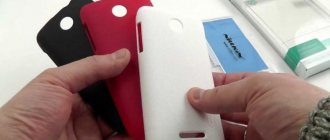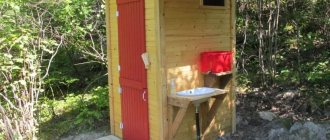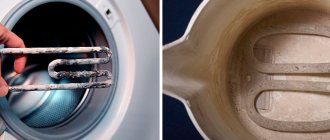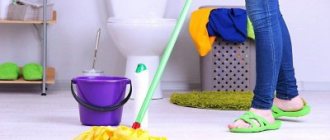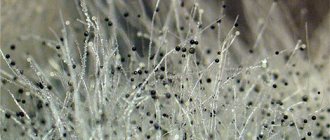When conventional toilet cleaning products don't help, you have to take drastic measures. I found a recipe on the Internet that I now recommend to all my friends. You need to mix washing powder and “Whiteness” and apply the slurry to the contaminated surface. Urine stone and all dirt will disappear without effort. But! There is a nuance that needs to be taken into account.
Causes of plaque
Previously, the water that enters the water supply system goes through a purification system and disinfection stages. Despite this, it contains elements of calcium and magnesium. They leave a cloudy limescale residue on the walls of the toilet.
The second reason for the appearance of stains is considered to be a malfunction or poor performance of the tank. Waste products are poorly flushed and, over time, form urinary stones in the once clean toilet.
Also, one of the reasons is the use of the toilet for other purposes: leftover soup and tea leaves are poured into it, which leads to discoloration of the surface and clogging.
The material, the basis of the device, also matters. Earthenware surfaces remain untouched by salt formations longer, while those covered with enamel, due to their roughness and porosity, become dirty faster.
Should I use it for washing?
Whiteness is a product that is produced in accordance with an approved standard. At its core, it is a transparent liquid with a slight yellowish tint. Contains sodium hydrochloride and surfactant with caustic soda.
Thanks to the active components, the solution successfully copes with various types of contaminants . The action occurs due to the occurrence of oxidative processes.
The use of the solution allows you to eliminate odors and organic pollution. This ensures disinfection and eliminates fungus from surfaces.
Due to the aggressiveness of the action, Whiteness cannot be considered a universal means of wide application. If it is necessary to treat floors with this substance, the type of coating should be taken into account. Only resistant surfaces can withstand intense exposure to alkali.
Rules for working with household chemicals
You cannot mix two or more types of products at the same time in order to wash off rust and plaque in the toilet, as the following situations may arise:
- There is a possibility that a dangerous chemical reaction will occur that will damage the sewer pipes or cause an explosion;
- The vapors of the two derivatives, when mixed, negatively affect the eyes and respiratory organs of a person, skin (a migraine or an allergic reaction begins);
- When combined, some elements create a fire hazard.
When treating toilet equipment from plaque, it is important to protect yourself from inhaling harmful fumes and coming into contact with the product. The mouth is protected with a medical mask or respirator, hands with rubber gloves. The door to the toilet is left open.
Attention, nuance - precautions
“Whiteness” is an unsafe remedy in itself. You can easily inhale the caustic gas released, not to mention the liquid getting on your skin. It is strictly prohibited to combine it with other chemicals: a violent chemical reaction may occur. Washing powder is also prohibited. I found this out after trying the product. I didn't notice any negative effects. But I couldn’t help but mention the existing danger.
We recommend: How and how can you quickly clean an artificial stone sink from dirt and plaque?
When using a paste of washing powder and “Whiteness”, you should take all precautions:
- Wear protective gloves and, if possible, a mask and goggles.
- Before cleaning, open doors and windows and turn on the hood.
- Do not lean over the cleaning agent or inhale the fumes.
- Mix the paste carefully, avoiding the formation of splashes.
- Leave the toilet immediately after treatment.
- After cleaning is completed, ventilate the room well.
If something goes wrong and you feel a burning sensation in your throat or shortness of breath, you need to go out into the fresh air and breathe deeply. You can also drink water or milk. If there is no improvement, you should call an ambulance. In case of contact with skin, the product should be washed off as quickly as possible with cool water. If a burning sensation is felt, it is necessary to lubricate the skin with ointment with panthenol or vegetable oil. If it worsens, it is better not to risk your health and consult a doctor.
How to remove water from a toilet for cleaning
If you start work with water in the neck, the concentration of products will not be enough to completely destroy drips and formations. You need to remove all the water from the toilet to make it easier to clean the walls inside the container. There are three ways to do this:
- Wearing gloves, scoop out the liquid using a small long-handled ladle or disposable cup. Remove any remaining moisture with an old towel.
- Pump out the water using a technical syringe . Also blot off the remains with a rag.
- Place an empty plastic tube into the hole, press on it, and water is sucked out. Squeeze the liquid into a bucket.
All stages of work are carried out wearing gloves.
How to bleach a toilet at home
The simplest ways to keep plumbing clean: vinegar, salt, mustard, acid and Coca-Cola. Everything to quickly clean the toilet from annoying limescale and urinary stones is available in every home. And such assistants are inexpensive.
Cleaning with soda and vinegar
How to clean a toilet using folk remedies without causing damage to the pipes: for minor stains, use the simplest methods. In the first place in the fight against old stains is ordinary baking soda and table vinegar. The method is suitable for allergy sufferers. Procedure:
- Soda is diluted with water, brought to a paste;
- Use a soft sponge (so as not to damage the surface of the toilet) to clean the outside of the equipment;
- Under the rim, remove dirt with the side made of abrasive material;
- Sodium bicarbonate is poured inside;
- Immediately pour 20% vinegar;
- An alkaline reaction occurs, the solution corrodes all stones, streaks of rust and cloudy deposits.
- After 5-10 minutes, rub the formation with force with a brush, leaving the yellowed brush in the hole.
- Flush out of the tank. If the dirt is not completely removed, repeat the process again.
Mechanical methods for removing plugs
Another direction in cleaning clogged sewers is mechanical methods, which often solve the problem without the use of chemicals or improvised means. However, it is worth immediately noting that it is mechanically impossible to remove blockages caused by a thick coating of urinary stone or rust - a set of measures is used to clear them.
Cleaning with a plunger
This is a well-known and perhaps the most popular method, which often provides good results. For example, in cases where a plug has formed in a sewer pipe or toilet elbow due to coffee or tea grounds constantly being poured into it.
We recommend: Drawing of a country toilet: diagrams and projects of the best homemade products
A plunger that has a nozzle with a cut cone at the end, with a cut diameter of 100 mm, works more effectively.
Most often, a plunger easily copes with breaking through a clogged pipe, if the plug is not old.
When cleaning a drain with a plunger, the toilet bowl must be filled with water. Then the plunger is installed in its drain hole and several pumping presses are made. After this, the device is sharply pulled out of the hole. This procedure is repeated several times if necessary. If the blockage was minor and had not yet “solidified”, after removing the nozzle from the drain, the water will actively drain into the pipe.
Homemade plunger from a plastic bottle
If there is no plunger in the house, and the toilet needs to be cleaned urgently, then a regular one and a half liter plastic bottle will do instead. To turn a bottle into something like a plunger, the bottom is cut off, but the rounding around the hole must remain, that is, only its lowest hard part is removed.
Cleaning drains using a regular plastic bottle.
The process is carried out according to the same principle as using a plunger with a rubber nozzle. The cut side of the bottle is lowered into the drain hole and pressed well against its walls. Then several pressing movements are made, after which the “tool” is sharply removed from the drain.
Using a plumbing cable
Another device that will get rid of the blockage 100% if it has formed in the toilet elbow or in the pipe to the common riser is a plumbing cable. The device is a rigid spring with a handle attached to one side. The cable can have different lengths, depending on the conditions in which it will be used. For autonomous sewerage, a cable 15,000 mm long is sometimes required.
One of the most effective solutions for mechanically cleaning toilet clogs is a plumbing cable.
Cleaning with a metal cable is carried out due to its flexibility and ability to move into the sewer pipe to a considerable depth through curved sections.
Using a cable with a spiral attachment at the end, you can try to pull out foreign objects that, for example, a child threw into the toilet
The work is carried out in the following order:
- The end of the cable is lowered into the toilet drain until it hits the resulting plug.
- Then you need to start slowly rotating the handle, pushing the cable inside the pipe. As it moves forward, the cable will move the blockage.
- The final step of this procedure is to flush the pipes with hot water with the addition of technical soda.
If there is no cable, then you can try cleaning it using a rigid but flexible cable, the main thing is that it has the required length and diameter. It is pushed into the sewer pipe through the toilet, turning it periodically. Thanks to such actions, you can destroy the plug blocking the pipe, or push through an object stuck in the pipe or elbow.
Cleaning with a cable should be carried out with special care if the toilet is connected to the sewer pipe by thin-walled corrugation. It doesn't take much effort to break through such a wall.
Check out the types of grease traps for sewage and their installation from our new article on our portal.
Film plunger
In South Korea, a special high-strength film-plunger “Pongtu” has been developed, produced and supplied to the Russian market, which can be easily used for any size toilet.
Clearing a clogged toilet using a special film plunger. The process occurs without unpleasant splashing of water on the sides
The film is glued to the top of a toilet bowl filled with water, and then pressure is applied intensely and rhythmically with both hands. Thus, this device operates on the principle of a plunger, but there are no splashes flying in different directions or even in the face, which often happens during normal cleaning.
If you come across such a set of two films on sale, it would be a good idea to purchase it for an emergency.
The kit comes with two disposable films and is a good idea to have on hand in case of unexpected clogs.
Acid solutions of different concentrations
Folk remedies are suitable if the dirt has not accumulated for years. To remove thick plaque, the old technique uses strong acids.
Oxalic acid
Oxalic acid is considered a technical agent that is used in preparing surfaces before applying enamel. The powder is used dry or diluted with water. The prepared mixture cleans the toilet from both urinary stone and rust. The product is toxic, so you cannot work with it without a respirator and hand protection.
Phosphoric acid
A component of Coca-Cola, orthophosphoric acid, can be used in apartments with plastic pipes: its action will not disrupt the operation of the sewer system. But it will cope with rust removal successfully. Exposure time is 15-20 minutes. Operating procedure:
- 100g of the substance is placed in a tank;
- 100g is poured into the toilet;
- After 15 minutes, treat the inner walls with a brush;
- Wash off the solution;
- Refill the reservoir and rinse.
Hydrochloric acid
Unlike the previous option, hydrochloric acid is not suitable for plastic pipes; the solution will damage the system.
200 g of the substance is placed in a container and the mixture is smeared inside with a brush. The toilet lid is closed after the procedure. The exposure period of the base is about 10-15 minutes. You need to rinse off the component well and ventilate the room.
Instructions
The rules for preparing the Whiteness solution can be found on the packaging of the product. The processing algorithm can be as follows:
Free the floor surface from objects that make cleaning difficult.- Prepare a rag and make an aqueous solution.
- Test the effect of the solution on an inconspicuous area.
- If after a quarter of an hour there are no unpleasant consequences or discoloration, proceed with the main cleaning.
- Moisten a rag in the prepared solution.
- Squeeze.
- Wipe the floor, paying attention to corners, baseboards and hard-to-reach areas.
- If stains are found, treat them separately.
- Ventilate the room for a quarter of an hour.
The recommended frequency of treatment with Whiteness is once a week.
Chemicals
Before you think about how to clean the toilet with chemicals, you need to thoroughly rinse and treat the tank. No less dirt and bacteria accumulate inside the drainage device, hence the smell and additional contamination of the toilet bowl. First, you can use a milder option - folk remedies. 2-3 days after this, begin more stringent measures.
Iodine monochloride
Iodine monochloride is a preparation for disinfection and disinfestation of premises and equipment. Works the same as an antiseptic. A yellowish solution is sold in veterinary pharmacies. Method of use to remove dirty stains in the toilet: pour directly onto the stone formations and immediately rinse.
The substance should not be used in systems with cast iron pipes or used in aluminum devices.
Battery electrolyte
To dissolve a large urinary stone in the toilet, take liquid battery electrolyte. For convenience, prepare a small plastic bottle. Then screw the lid on and punch a hole with a pin through which the solution will be poured. Place 100g of the composition in the prepared container.
Wipe the surface before starting work; the walls of the toilet bowl must be dry. Carefully spray the substance onto the dirt. After 2-3 hours, the treatment can be repeated and left for another 2 hours.
Chlorine
Chlorine is used in dry or liquid form. Disinfectant powder is applied to a dry surface. The liquid is added 2 times to cover drips and rust, with an interval of 30-40 minutes. The period of exposure to the composition is increased depending on the degree of contamination, by approximately 3 hours.
After this time, you need to scrape off the remaining urinary stone with a spatula, being careful not to damage the enamel. The final stage: treatment with water and a brush.
My experience of cleaning the toilet with powder and “Whiteness”
None of us are immune from encountering plaque on the toilet, against which ordinary cleaning products are powerless. This situation has happened twice in my life.
For the first time, not very clean guests moved out of the apartment I rent out. They turned a brand new toilet, barely more than a year old, into something out of a horror movie. The snow-white surface was covered with a yellow-gray coating of either urinary stone or something else. I was terrified.
After fruitless attempts to wash everything with the usual “Chistin”, my hands gave up. “Do we really have to leave everything as it is? Well, I do not!" – I thought and decided to take radical measures. I came across a recipe on the Internet that inspired me with confidence.
Washing powder and “Whiteness” are two effective products. “Whiteness” corrodes dirt, destroys microbes and whitens, and the powder cleans surfaces and facilitates the separation of plaque from the walls. Following simple logic, together they should act as efficiently as possible.
And indeed, I was not mistaken in my choice. The result exceeded all my expectations! After 2 hours, the plaque completely fell off, and the toilet began to shine as if it were brand new.
The second incident happened in my house. Having gone on vacation as a family, we did not turn off the water well enough. When we returned after 3 weeks, we saw an “oil painting” - the toilet was covered with a yellow mesh from the water. Horrible-looking deposits had also formed in the bowl. And here the miracle paste helped with a bang.
Household chemicals
Special effective products for making plumbing fixtures white, namely for cleaning the toilet, are purchased in hardware departments or in household chemical stores. The range includes:
- white;
- powders;
- liquids;
- gels;
- creams;
- tablets for the tank.
White
To treat with whiteness, you need to prepare the device: drain all the water from the bowl and neck. Pour 1 liter of the substance inside, close the toilet lid and leave overnight.
Powders
The loose abrasive base and disinfecting properties of Komet allow you to get rid of plaque and rust in a short time. After pouring the mixture onto the dirty places, you need to rub the surface, let the substance work for 15-20 minutes and press the drain button. Doesn't work well with old stains.
Storage of the drug
Store Whiteness at room temperature. The manufacturer recommends keeping the drug out of the reach of children .
After the bottle has been unsealed, it is recommended to use its contents within 6 months, since the active components gradually evaporate from it, and the effect of use decreases.
One of the rules for storing and transporting containers is to keep the containers vertical and prevent the contents from freezing. This is due to the fact that after defrosting the product largely loses its quality. Whiteness should be stored out of the reach of children and pets.



